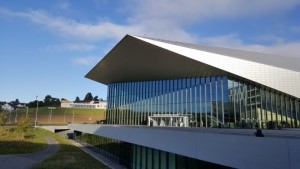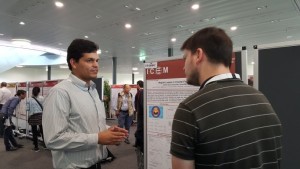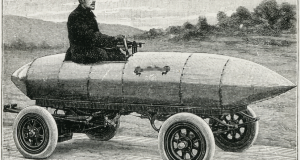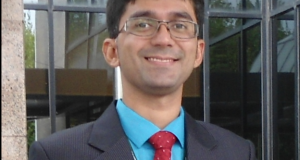AUTHOR: ADOLFO GARCIA GONZALEZ
This year the 22nd edition of the International Conference on Electrical Machines ICEM took place in Lausanne, Switzerland. Lausanne is located at approximately 40 minutes from Geneva Airport by train and situated on the coast of the Geneva Lake (Lac Léman in French). It is the host of the Olympic Committee.
ICEM is one of the oldest, largest and most prestigious international conferences focused on electrical machines organized every two years in a different location in Europe. Therefore, participating in this year’s edition was an excellent opportunity to meet people working in the field, learning about new trends in design of electrical machines and of course reuniting with former colleagues.
This 4 day event is divided in three parts:
- a workshop divided in six topics ranging from effects of frequency in inverter-fed AC machines to the reduction of core losses for high efficiency motors and even electrical machines for aerospace applications.
- six sessions with oral presentations of 180 papers in various topics related to electrical machines, design for especial applications, thermal and losses issues, sensor-less control of AC machines among others.
- three poster sections of around 250 articles, divided in different groups such as, special machines, design and related problems, flux-switching machines and drives, hybrid excitation synchronous machines, magnetic bearings and bearing-less machines. And interestingly, design and control of electrical machines for extreme environments.
Additionally, some exhibitors participating in this conference were Cedrat-Altair, Applied Magnetics and Infolytica Europe, who showcased their specialized Finite Element software for the design of electrical machines. I participated by presenting the article: “Magnet Losses in Inverter-Fed Two-Pole PM Machines” [1] in the category of Design and Related Problems. How does this article relate to the DEMETER project? In many ways this conference was relevant to my project in DEMETER, but most importantly in regard to magnet losses. NdFeB magnets have the strongest magnetic characteristics (remanence and coercivity) when compared with other type of magnets. However, NdFeB magnets have one weakness: heat. Heating might lead to irreversible demagnetization which indeed has a negative impact on the performance of a machine.
Magnets generally have a high conductivity, not as high as for the copper or electrical steel, but high enough for eddy-currents (or Foucault currents) to have an “easy” path for circulating. Eddy currents are induced by harmonics in the magneto-motive force (mmf) of the windings in the stator. The harmonics are originated by several factors: PWM commutation, slot effect, non-sinusoidal distribution of the windings, etc. These eddy-currents are flowing in a closed loop in a solid conductor, and they are not adding anything but heat due to Joule effect. Given the sealed characteristic of machines, cooling the rotor is a challenge. The situation is worsened by the presence of other losses such as air friction losses, bearing losses, etc. This, in turn, makes the heat generated inside the magnet unable to find a proper dissipating path.
Nevertheless, not everything is bad news. There are ways for counteracting magnet losses, and one of them is applying segmentation in both radial and axial directions. So, as you already have guessed, the calculation of losses in magnets is an important task that needs to be addressed by each designer in Work Package 3 (WP3) of the DEMETER project.
I apologize if I got sidetracked from the main topic of this blog, it is just that magnet losses is a very exciting topic :). Presenting a poster is demanding. It requires you to stand and answer the questions of the visitors for two hours. Some people just read what is printed on the poster; others have interesting questions and are eager to know more details about it. This knowledge exchange allows you to share the specifics of your research in a “two-way” mode: you are not only answering questions but also have the chance to discuss and ask about the work done by other participants in the conference.
In summary, ICEM is a very interesting route to disseminate the results of WP3 in DEMETER project and now researchers in WP3 might aim to participate in the 2018 edition which will take place in Alexandroupoli, Greece. Finally, a couple of images that I would like to share with you.
Fig 1. Swisstech Convention Center, Lausanne.
Fig 2. The author of this blog and a visitor at the poster presentation.
You can find more information about the conference here: www.icem.cc/2016. More information about motors here: https://etn-demeter.eu/lets-discuss-motors-in-electric-vehicles/ and https://etn-demeter.eu/why-we-need-a-new-motor-design-suited-for-magnets-recycling/.
Hasta la vista!
References:
[1] A. Garcia, J. Millinger and J. Soulard. “Magnet Losses in Inverter-Fed Two-Pole PM Machines,” Electrical Machines (ICEM), 2016 XXIInd International Conference On, Lausanne, 2016, pp. 1856-1862.

 European Training Network for the Design and Recycling of Rare-Earth Permanent Magnet Motors and Generators in Hybrid and Full Electric Vehicles (DEMETER)
European Training Network for the Design and Recycling of Rare-Earth Permanent Magnet Motors and Generators in Hybrid and Full Electric Vehicles (DEMETER)




